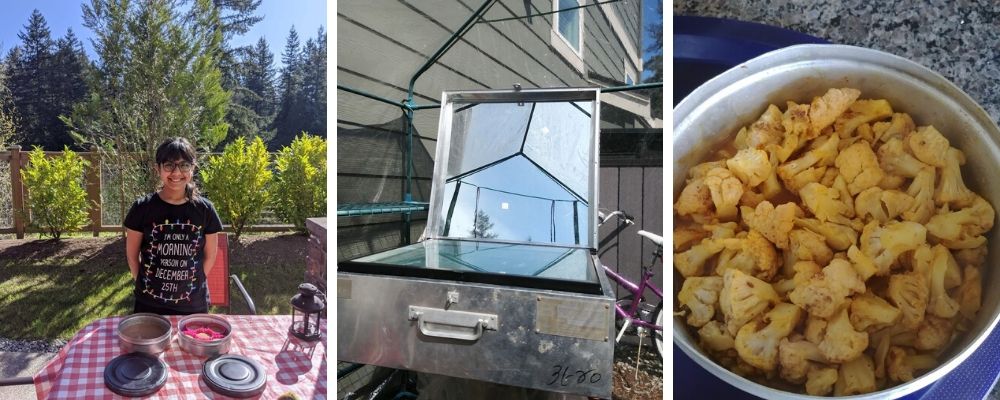
This is a guest post from 10-year-old Sharda Shah, the daughter of Mauli Shah who works in UW Medicine’s IT Department. As they have been looking for projects at home, this Earth Month they found a solar cooker sitting unused in their shed and decided to try it out. Here are Sharda’s thoughts on using a solar cooker, and how it shows solar energy can be useful even at small scales.
It is difficult to regain our motivation and desire to try new things during these new and unprecedented times. We all want life to go back to normal, and thus fall into unhealthy routines immediately. However, there is still hope and we must take control of our paths by delving into new experiences. With this in mind, my mother and I thought to honor Earth Day with projects involving a solar cooker. Solar cookers are, as the name suggests, solar-powered containers with the ability to heat the contents to high levels. Our decision was to cook different sorts of cuisines in the solar cooker, such as rice, pasta, lentils, beans, and various baked pastries.
One must understand the systematic method that a solar cooker is used. It is designed to capture the maximum amount of light from the sun possible, and subsequently convert the light energy to thermal energy utilizing the process of conduction. To maximize the heat absorbed, the cooker is painted dark black. As we learned, placing the solar cooker in a greenhouse or a similar non-opaque enclosure allows for the best results. The photons can go through and heat up the solar cooker; however, the heat energy is trapped due to the physical barrier and causes the food to heat up faster.
The solar cooker that we utilized was a square box with four parts – it consisted of an outer box made of metal, a dark black metal inner box, the glass cover, and four mirrored aluminum containers. There is an insulation layer between outer box and inner box to hold heat. The box was fitted with a handle and wheels for convenience. It weighs approximately twenty-five pounds.
We baked a cake, among other items, in the solar cooker. It turned out amazing. We made batter using a regular chocolate cake recipe. Then, we tried putting the batter in one of solar cooker containers directly as well as in silicon cupcake liners (and put those liners inside a container). It took three hours to cook. The silicon liners were not successful, however, the cake in the container was very spongey and tasted delicious like a normal cake. We tried rice, quinoa, pasta and those were ready in one hour. The quinoa texture was perfect for a quinoa salad. We tried different lentils and beans (soaked the night before) which required little more time. We used beans to make burritos and it tasted super good. It even tasted better than the beans we cook on the stove. I also cooked vegetables like cauliflower, cucumber, bell pepper, spinach, tomato for soup, mixed vegetables and many more. The possibilities to this solar cooker have no end. My next items are sun baked tomatoes, raisins and salted nuts.
I encourage everyone to use this natural source of energy as much as possible. It helps environment by reducing air pollution, limits the risk of a fire hazard, and - of course - makes delicious food. I am thankful to my language teacher for encouraging me to share this experience and sister Meha Shah who helped compiling this essay.